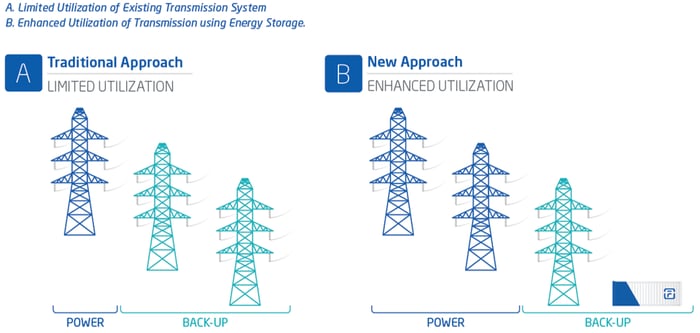The world of transmission planning is, for the uninitiated, often highly technical and complex, but what it’s really all about is outcomes—reliability, market efficiency and enabling public policy goals. As we move toward a modernized grid, choosing between energy storage and traditional grid assets should be about finding the right mix and balance to achieve those goals.
I come at this issue from a very practical perspective—before joining AES Energy Storage and, then, Fluence, I spent 10 years working on various aspects of transmission planning. I know that here in the United States and elsewhere, we have 100-year-old poles and wires that urgently need replacing; we have massive, 345- and 500-kilovolt (kV) backbone connections that are essential for delivering power to and between our metropolitan areas. We need several new transmission lines to integrate ever-growing amounts of renewables. Make no mistake: these projects should be built, and aging infrastructure, particularly backbone systems, should be replaced.
Storage is not a cure-all for all the current challenges in our transmission system. As laid out in our new white paper, “Redrawing the Network Map: Energy Storage as Virtual Transmission,” it is a tool that can be used to increase grid efficiency, accelerate the deployment of new capacity in the appropriate size increments and provide significant savings for utilities and their customers.
The questions we often ask at Fluence are, first, what are the specific jobs a system, such as the transmission grid, needs to perform, and then, what technology is the best fit for getting those jobs done?
On-Demand Capacity—Getting it exactly when and where you need it
Answering those questions means getting down to basics: our electric power grid was and continues to be designed to be ultra-secure, with multiple layers of redundancy to handle peak power demands and stay in operation even if a power plant or a transmission line goes down. This level of reliability is absolutely critical, but it also means the system has to be oversized and, thus, underutilized. When I testified before the U.S. Senate earlier this year, Sen. Angus King (I-Maine) mentioned that our transmission system is like a church sized for Christmas day; such a good analogy.
What makes this issue even more complex is that the alternating current (AC) on our transmission lines cannot be controlled. We simply don’t have a metric for the grid that is comparable to the capacity factor we apply to measure how much of a generation asset is being used. No one talks about a “grid utilization factor,” not because we don’t like to but because it’s a difficult exercise to collect and analyze such data. We can build wires with a certain amount of capacity, but once electrons are generated and head out to find the path of least resistance to the nearest load, we can’t tell exactly how much of those wires’ capacity is being used.
All of which makes transmission planning a bit of a complexly coordinated dance. We plan our system based on predictions of demand growth, which we then translate into the need to build more transmission to ensure reliability, without asking how much of a line’s capacity has been or will be used. It’s kind of like building a four-lane highway but only allowing cars on two lanes because you might need the extra space if an accident occurs elsewhere on the interstate, and traffic is then redirected to your road. You can practically hear the frustrated howls of motorists driving by those wide open, empty lanes.
Storage helps existing transmission assets to be used more efficiently at any point in time (see figure below). Like an extra lane that appears whenever and wherever it is needed, it can provide the added capacity—at the right size and with a smaller footprint—to ensure reliability and redundancy.

Improving Utilization with Virtual Transmission
Take, for example, the case of Punkin Center, a small town on the outskirts of Phoenix, Arizona, served by a transmission line sized to handle its annual peak electricity demand. As the town started to grow, so did its peak demand. New lines couldn’t be sized exactly for that peak load growth; storage can. In this case, the utility, Arizona Public Service (APS), decided to deploy energy storage instead of upgrading the 20-mile, 21-kV transmission line that serves the town—a great example of “right-sizing” the grid.
Accelerating adoption in Germany, Australia and the U.S.
Around the world, grid planners are beginning to see the value of using energy storage as a transmission asset. However, as is often the case in such transitions, adoption is moving at different speeds and levels of intensity in different regions.
Germany has taken a particularly proactive approach. The country’s GridBooster plan aims to put 1,300 MW of energy storage on the grid by 2025, to relieve congestion on transmission lines and reduce costs due to the resulting inefficient dispatch of power. The increased market efficiency from better dispatch of least-cost generation has yielded savings estimated at 130 million euros per year.
Meanwhile, in Australia, energy storage has been proposed as a network option in studies to evaluate various transmission lines.
In the U.S., we have seen storage proposed to relieve congestion and improve efficiency in markets such as PJM Interconnection. Just recently, American Transmission Company (ATC) received preliminary approval from the Midcontinent Independent System Operator (MISO) for its first storage-as-transmission project.
Several forward-leaning transmission companies are also beginning to include energy storage as a resource in their grid planning activities, based on the value storage provides against traditional wires options. In my view, these analyses and actions should significantly accelerate the adoption of energy storage as transmission in the U.S., as will a concerted effort to share information and lessons learned along the way. Providing regulatory certainty at state and federal levels will also provide impetus for this application of energy storage.
The growth of energy storage as a transmission asset will ultimately depend on the freedom transmission planners have to use it as an option to provide reliability, without building new wires, when and where such an approach is truly the best solution. It should not be an either-or proposition, but one in which we work together to advance the energy system transformation that, in a world increasingly powered by renewable energy, cannot come soon enough.
Want to find out more or share information about energy storage as a transmission asset? Contact Kiran Kumaraswamy, Fluence Vice President of Market Applications, at VirtualTransmission@fluenceenergy.com.

















